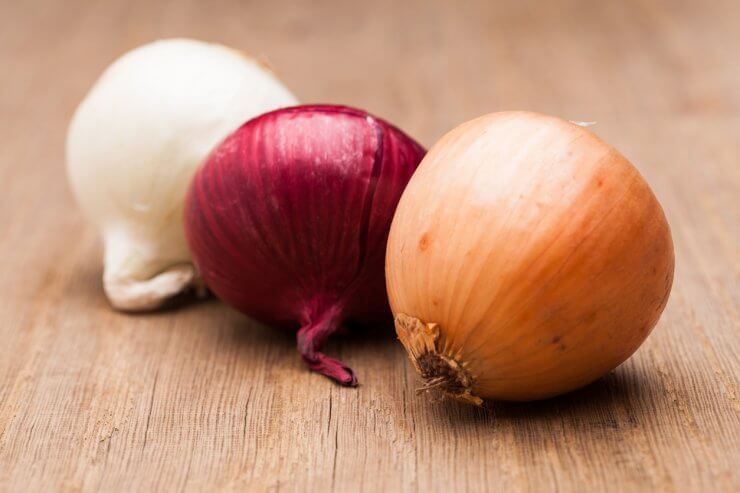
Three varieties of onions
There are a few ways to categorize onions: by color, by season, and by day length. And then there’s the choice between fresh and storage onions. Here is a summary:
Onions by color
Yellow
- Comprises about 85% of the U.S. onion crop
- Flavor ranges from sweet to mild to richly flavored
- The original all-purpose onion
- Sweet and mild types are good to eat raw, marinated, or gently cooked
- Full-flavored varieties are best for grilling, roasting, and caramelizing
- The onion of choice for French onion soup
Red
- Comprises about 10% of the U.S. onion crop
- Commonly used raw on sandwiches and in salads
- Can be eaten raw or pickled
- Good for grilling and roasting
White
- Comprises about 5% of the U.S. onion crop
- Raw white onions have a distinct flavor but no aftertaste
- Good eaten raw or sautéed
- Popular choice for stir-fry, deli salads, and sandwich toppings
And just to make life interesting, there’s also another white onion category:
Sweet
- Larger and with thinner skin than most other onions
- Very tasty raw
- Good in salads and on sandwiches, grilled, roasted, or as onion rings
Onions by season
Spring/Summer:
- Available: March to August
- Skin: one or two thin layers
- Water content: high
- Shelf life: 30 to 60 days
- Flavor: sweet to mild
- Uses: raw, pickled, gently cooked, or grilled
Fall/Winter:
- Available: August to May
- Skin: many thick, paper-like layers
- Water content: lower than spring/summer onions
- Shelf life: 30 to 180 days (sometimes more)
- Flavor: mild to pungent
- Uses: caramelized, roasted, or fried
Onions by day length
Day length refers to the number of daylight hours onions need in order to form bulbs. If they don’t get all the sunshine they need, they won’t grow properly. You want to check not only your growing zone, but your specific garden area to make sure the onions you want to grow are suited for successful growth in your particular garden.
Short day varieties
- Need 10 hours of sunlight a day
- These varieties grow well in USDA Plant Hardiness Zones 7 and up
- Cultivars include Red Creole, Red Burgundy, White Bermuda, Early White Grano, and Yellow Granex
Intermediate day varieties
- Also called day neutral
- Need 12 to 14 hours of sunlight a day
- These varieties grow well in most parts of the U.S. Midwest, in zones 5 and 6.
- Cultivars include Candy, Utah Yellow Sweet Spanish, White Sweet Spanish and Superstar
Long day varieties
- Need 14 to 16 hours of sunlight
- These varieties grow well in zone 6 and colder
- Good for long-term storage
- Cultivars include Southport Red Globe, Walla Walla, Ailsa Craig, Patterson, and Redwing
Fresh and Storage Onions
Before choosing your onion plants, consider how you want to use them. Your growing zone, of course, will certainly influence your choice. You will likely need to choose between fresh onions or storage onions.
Fresh onions are the spring/summer onions. They include such varieties as Walla Wall, Red Burgundy, White Grano, and Italian Torpedo.
Storage onions are your fall/winter onions. Those varieties include Redwing, Southport Red Globe, and Patterson.
Shallots are a variation of bulbing onion and have a reputation for playing a prominent role in gourmet cooking. You don’t have to be a gourmet to cook with shallots, nor do you need to have gourmet plans to grow them. They grow pretty much the same way that bulbing onions do and are considered to be a long day variety.
What type of onions have you tried growing? Which do you prefer? Please share your opinion in the comment section below.


 Previous
Previous


Just an FYI….commercially we try to keep our storage onions in cold rooms at roughly 34+ degrees and 75% humidity.
Hi Bob,
Thanks for sharing your storage tip, I am sure our community will find that helpful when they think about storing their onions!
Norann
Great question Barbara! I’ll try to explain without getting too “sciency.”
During the spring equinox the length of day and night are the same. But in the months immediately following the spring equinox, the earth is tilted so that the northern regions get more hours of sunlight each day and fewer hours of night. While the days lengthen in the spring, onions are busy growing vegetation. As daylight reaches 14 to 16 hours in the summer, this signals the long day onions to focus energy on bulbing.
Good luck with your onion crop!
Why are the varieties that need more hours of sunlight better for northern gardens?
Roxann,
I had not heard of this method for storing onions before. It sounds like a great idea, especially for those who may have limited storage options. Thank you so much for sharing!
I find that if I wrap each onion in foil and refrigerate them they last for months.